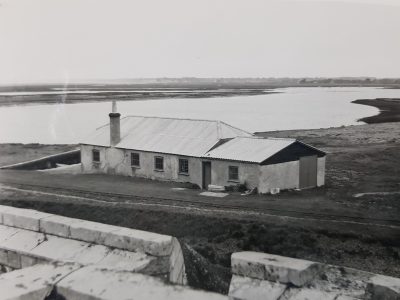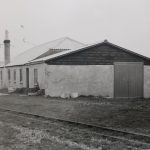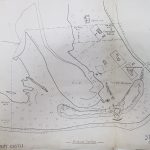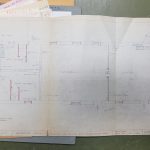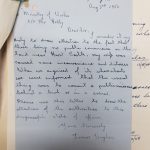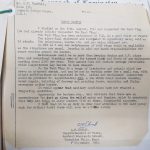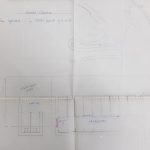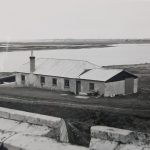The Challenge of Refreshments and Toilets at Hurst Castle
File WORK 14/1551 held by the National Archives is concerned with the provision of toilets at Hurst Castle and contains some rather interesting more material and information than the title at first suggests.
The file starts in 1936 with correspondence between a Mrs Barnes and the Ministry of Works about the annual renting and then conversion of the Governor’s House (Marked with an X in the plan) into a refreshment room and toilets. At this point the Governor’s House is being used as a store. Discussion goes back and forth on whether the Ministy would be responsible for making the building fit for purpose and then Mrs Barnes for decorating and paying back some of the conversion costs into her annual rent, which was recommended to be £10 a year for 2 years as venture was unlikely to make any profit in the first year.
Correspondence suggests that this arrangement for refreshment facilities would be advantageous for both sides and would lead to a large increase in the number of visitors to the Castle. It turns out that Mrs. Barnes was also the tenant of the Corporation’s Tea Rooms in Milford and offered to prominent display there about the castle along with photos and as the Corporation’s Tea Rooms are in the most prominent part of the Sea Front and Bathing Beach and are visited by hundreds of visitors, most of whom have never heard of the castle, much less visited it, it would doubtless have the effect of attracting more to the Castle.
A plan of the suggested 1936 conversion are included in the file. There is a hiatus in the files between 29 April 1936 and 2 November 1954, but later correspondence suggests that the works did go ahead and a café and toilets were in operation from the Governor’s House until the outbreak of the Second World War when the castle was re-armed and occupied by soldiers by the military.
The correspondence picks up again discussing the need to provide new toilets at Hurst for visitors, with a cost of between £400 and £750 being discussed to bring the Governor’s house back to useable condition. One of the letters dated 9 June 1955 states there is no money in the years budget to do the work though and also that the governor’s House still forms part of the Castle which is still occupied by the War Department and appears in the Schedule of Buildings of Historic Interest occupied for military purposes.
As a little side note one of the documents details the number of Castle visitors, which shows increasing numbers from 1951 onwards really pushing the need for toilet provision:
- 1951 – 4,200 visitors
- 1952 – 5,121 visitors
- 1953 – 6,289 visitors
- 1954 – 9,200 visitors
A letter dated 30 September 1955 from the Ministry of Works relinquishing the East Wing of Hurst Castle from the military schedule, which starts a whole new bunch of correspondence on whether toilets can be refurbished within that wing. This is still going back and forth when the Castle Custodian; R. Nobby receives a letter of complaint from a Mr Trevor Hughes about his wife’s inconvenience during a visit to the Castle
‘I consider it my duty to draw attention to the fact that there being no public convenience on the land near Hurst Castle, my wife was caused some inconvenience and distress. when we enquired of its whereabouts we were informed that the usual thing was to commit public nuisance behind a bush or in a corner.’
A visit by A. F. Church the Superintendent of Works from the Ancient Monuments Branch brings the issue into further focus.
‘It would appear that the sanitary conditions have now reached a disgusting condition. Apparently the boatmen etc., tell visitors there are no conveniences “so just go along the walls2, males and females, which is precisely what they are doing in large numbers with at times. disgraceful exposure. I feel that it is my duty to draw your attention to the last paragraph for without doubt there will soon be a public outcry”
At this point correspondence back and forth between the council and the ministry is now focused on provisions of toilets inside the castle for paying visitors and what might be done for other visitors to the spit, that doesn’t require the time or attention of the Castle custodian.
‘we have for a long time been aware of this need, but while the War Department remained in occupation after the war it was not possible to find suitable accommodation. since the military left, we have been preparing a programme of work which will include the provision of lavatories for visitors to the castle. the programme is not finally decided, but it is clear that the only available place for the lavatories will be in one of the 18th century wings of the castle.
Unfortunately it is not possible to provide separate access from outside and therefore the lavatories would not cater for the people who visit the point for fishing or other activities and who would not be willing to pay the admission fee to the castle. This category is believed to be quite large, and although we do not regards it as the ministry’s responsibility, we have been considering whether a suitable site can be found near the castle for a lavatory to service these visitors.
from the archaeological point of view, the castle ought to stand on the point in isolation, with the later buildings cleared away. However, the lighthouse has to stay, and we would therefore willing to provide at a minimal cost a site to the rear of it which your council could erect a lavatory. Attendance is likely to be a major difficulty as our custodian will be fully occupied in looking after the increased area of the castle which will be on view to visitors, and will not be able to clean and attend to an outside lavatory.
A hand written amendment in a different hand at the end of this letter observes:
This is an odd situation, our land (ex WO) seems to be a ‘holiday centre’ for all and sundry. There is a need for public lavatories and we should welcome it for the obvious reasons. We can only cater (by provision of lavatories in one of the wings) for visitors, fee-paying, to the castle. therefore, the suggestion that we lease some land to the council for the purpose seems a good idea.
By summer of 1958 when the file comes to a close facilities were provided within the West Wing under one of the lighthouses for paying visitors; the ones that are in use today, whilst the general visitors to the spit still have no official provision!
The Governor’s house photographed in 1954 has now been demolished.
You can discover more articles about Hurst Castle on New Forest Knowledge by visiting: Hurst Castle – Overview


